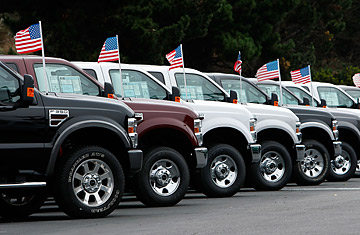
A row of new Ford trucks are displayed at a Ford dealership Sept. 4, 2007, in Colma, Calif.
The Detroit Three's Business Plans
Scheduled to be delivered to the Senate Committee on Banking, Housing, and Urban Affairs on Dec. 4, 2008
The Gist:
When CEO's Bob Nardelli (Chrysler), Alan Mullaly (Ford), and Rick Wagoner (GM) appeared before Congress late last month in search of a bailout, they were basically told, "Get the hell out of here until you have detailed plans to get your industry in order." Well, here they are: Three business plans, numbering between 14 and 37 pages, providing a detailed outline of how each executive plans to turn his company around — and what the Federal government can do to help.
Highlight Reel:
1. On how much money they're asking for:
GM: "An immediate temporary Federal loan in the amount of up to $4 billion in the month of December 2008 ... GM would look to draw up to an additional $4 billion in January to fund operating losses caused by very low levels of North American production ... If industry conditions do not improve materially, GM would access another $2 billion ... bringing the total draw to as much as $10 billion by the end of the first quarter 2009."
Chrysler: "A $7 billion secured working capital bridge loan by December 31, 2008."
Ford: "A 'stand-by' line of credit, in the amount of up to $9 billion. This line of credit would be a back-stop to be used only if conditions worsen further."
2. On how they've cut back:
GM: "Employment [has been] reduced 42% from 167,000 to 97,000 ... GM is immediately ceasing all corporate aircraft operations, unfortunately impacting approximately 50 hourly and salaried employees."
Chrysler: "By the end of 2008 [from 2007], Chrysler will have separated over 32,000 employees, including 5,000 white collar employees who left the company just this past Wednesday before Thanksgiving. Cost cutting has been substantial, swift and wide-ranging. Nothing has been viewed as 'sacred.'"
Ford: "We have taken painful but necessary downsizing actions to match capacity to real demand, including closing 17 plants over the past five years and downsizing by 12,000 salaried employees and 45,000 hourly employees in North America in the past three years.
3. On what happens if they don't get the money:
GM: "GM must reluctantly, but necessarily, turn to the U.S. Government for assistance. Absent such assistance, the company will default in the near term, very likely precipitating a total collapse of the domestic industry and its extensive supply chain ... The cost of failure in this instance would be enormous for everyone ... Regionally a failure at GM would devastate Michigan and other Midwest states."
Chrysler: "[If we have to liquidate], 53,000 out of the Company's 55,000 hourly and salaried employees would be terminated immediately representing over $7.2 billion in annual wages and healthcare benefits....Over 3,300 dealers would go out of business and over 140,000 employees at dealerships would lose their jobs."
Ford: "We are acutely aware that our domestic competitors are, by their own reporting, at risk of running out of cash in a matter of weeks or months. Our industry is an interdependent one. We have 80 percent overlap in supplier networks. Nearly 25 percent of Ford's top dealers also own GM and Chrysler franchises. That is why the collapse of one or both of our domestic competitors would also threaten Ford."
The Lowdown:
Ooh boy is the auto industry in trouble. You can tell how bad each company is doing just by looking at these hard copy reports. Ford, which seems best-equipped to ride out the economic storm, puts together a forward-looking document full of boxed-off pull quotes. The more dire GM ("Recent significant declines in dealer orders are now adversely affecting first-quarter production schedules and revenue forecasts") packs its statement with charts and graphs and lots of diverting graphics. And Chrysler? It's 14-page document, half the size of the others, looks like a college sophomore's final term paper.
There's a fair share of defensive in these documents, but also a decent amount of penitence. It's fascinating to see these behemoth companies admitting that they've made mistakes in the past and realizing that they need to shift production to smaller, more fuel-efficient vehicles (though it does seem as if they're just tossing that in there because such talk is all the rage these days). Who knows how much is genuine. Can giant corporations be genuine about stuff like that? Yet the case is also effectively made that the failure of the Big Three would be absolutely disastrous for a ton of people. Reading these reports leaves one feeling an odd combination of anger and pity.
As to whether these plans are enough to justify another several billion dollars worth of taxpayer money, that's up to Congress to decide.
The Verdict: Skim
